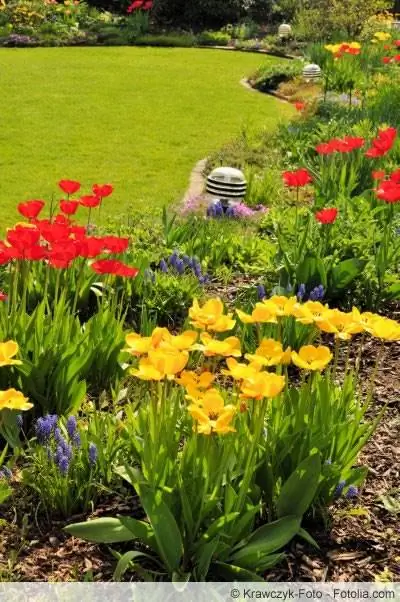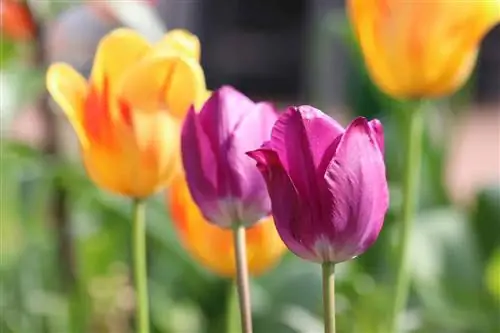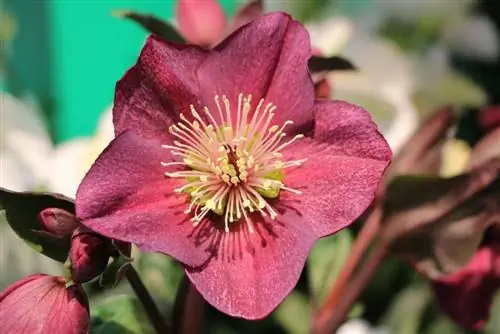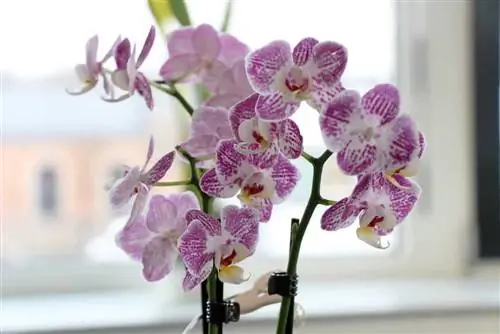- Author admin [email protected].
- Public 2023-12-17 03:39.
- Last modified 2025-01-24 12:45.
The recurring references to the toxic content in tulips are causing uncertainty among hobby gardeners. Are tulips poisonous? Since a general answer in this case would be far too undifferentiated, further facts are required. To ensure that the annual joy of the colorful spring flowers is not unduly dampened, the following information about tulip leaves and flowers provides more information. Only when adequate conclusions have been drawn for the individual situation in your own garden can a well-founded decision be made regarding the actual risk potential.
Poisonous Tulip Bulbs
Toxic tulpisoids are contained in all parts of a tulip plant. The highest concentration of the toxin tulipanin is found in the onion. Since this flower bulb looks very similar to a kitchen onion, accidental consumption can result in typical symptoms of poisoning. The most common symptoms are:
- Extreme nausea
- Violent vomiting
- Stomach cramps with diarrhea
If a large amount of tulip bulbs has been eaten, there is a risk of circulatory collapse and respiratory arrest. In addition, a drastic drop in body temperature was observed, with consequent shock. Since no hobby gardener walks through his garden to dig up and eat tulip bulbs, such occurrences are extremely rare.
Tulip petals irritate the skin
More common than poisoning after eating a tulip bulb is skin irritation after contact with tulip petals. The basal, sessile leaves reach a length of up to 30 centimeters and, with their rich green color, create a decorative contrast to the colorful flowers. They are usually integrated into the arrangement of bouquets, so that touching them is unavoidable. A typical tulip dermatitis is manifested by these features:
- Excema-like irritations develop on the skin
- There will be redness, itching and swelling
If contact with tulip petals extends over a long period of time, the fingernails become brittle, the skin flakes and small cracks form. Tulip scabies mainly affect people who work with spring flowers. If hobby gardeners cultivate tulips in large quantities, they are also not spared from the problems. The risk is particularly high when cutting back withered tulip leaves after flowering.
Don't taste the flowers
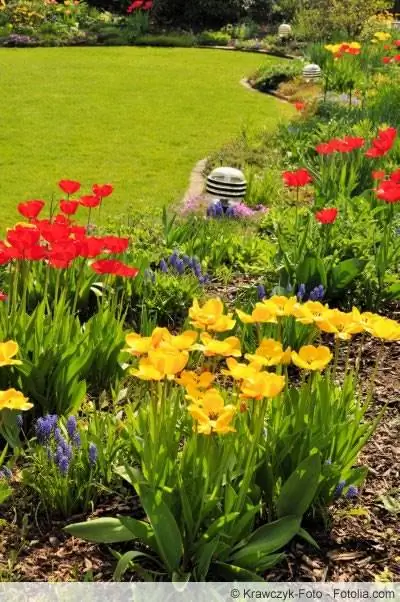
In the modern kitchen, housewives like to use colorful petals to decorate fresh dishes and drinks. While the flowers of petunias, roses or violas serve as a culinary enrichment, tulip flowers are strongly discouraged. Although the toxins cannot be detected in the extreme concentration as in the onion, sensitive people, children and seniors can get into distress if they snack on the floral decoration.
In addition, skin irritation cannot be ruled out if the flowers of a tulip are plucked to use as a table decoration or in a potpourri.
Tip:
The yellow-flowering wild tulip is subject to federal species protection. It may not be picked or dug up in the wild. Law-abiding plant lovers are therefore not exposed to the toxic ingredients of a wild-growing tulip per se.
First aid measures
If symptoms of poisoning occur after eating a tulip bulb, the following procedure is recommended:
- After consuming a small amount, drink plenty of water
- Consult your family doctor after consuming a large amount
- Depending on the intensity of the symptoms, the doctor will administer a charcoal medication or refer you to the hospital
Tulip dermatitis usually heals within a few days if contact with the flowers is stopped. Incidentally, skin irritation can also occur if only the flower bulb has been touched, as is inevitably the case when planting.
Targeted prevention
So that hobby gardeners are not confronted with the poisonous side of a tulip in the first place, careful prevention is important. Wearing gloves during all care and planting work is a top priority. This precaution also applies to picking tulips to use as a bouquet or arrangement. In addition, long-sleeved clothing prevents unwanted skin contact.
To avoid confusion due to their visual similarity, tulip bulbs should be stored separately from kitchen onions.
Tip:
Small children are not left to their own devices when they spend time in the garden. Tulips are by no means the only plants with toxic ingredients.
Toxic to animals
Tulips also pose a risk of poisoning for animals. Dogs, cats, rabbits, hamsters, guinea pigs and even horses are affected. Consumption of onions as well as tulip leaves and flowers is always problematic for animals. Classic signs of poisoning occur, such as increased salivation, vomiting and diarrhea. The animal becomes apathetic and refuses food. Depending on the intensity of the symptoms, the veterinarian should be consulted. It is particularly advisable to seek professional advice if the amount consumed cannot be traced. The following precautions serve to ensure effective prevention:
- Always plant tulip bulbs in a closed wire basket to protect them from digging dogs
- Do not use tulip leaves and flowers as food for rodents
- Do not dispose of clippings on horse pastures or on a compost heap accessible to animals
Since tulips release toxins into the flower water, the vases in the house should be placed in such a way that animals cannot drink from them.
Poisonous imported tulips
To give flowers as gifts on Valentine's Day, hobby gardeners also use imported tulips from the shops. At this early point in the year, the home-grown spring flowers have not yet bloomed. Not only are poisoning caused by tulipisoids lurking, but also due to pesticides on the tulip leaves and flowers. In Africa, Asia and South America, the flowers are still grown without regard for losses using highly toxic chemicals. Environmentally conscious buyers therefore choose goods from organic farming associations such as Bioland, Demeter or Naturland when purchasing. The FLP seal also indicates that the tulips come from cultivation according to controlled environmental standards.
Typical identifying features
To safely identify tulips, the following attributes serve as clues:
- Before flowering begins, 2 to 6 basal tulip leaves sprout first
- From April to May, each bulb sprouts an inflorescence with a terminal flower
- The height varies from 20 to 70 centimeters
- Tulips bloom in all shades from white to yellow and orange to red, blue or black
- A flower consists of two circles with different shaped bracts of different lengths
- The three-lobed scar in the center of every tulip blossom is unmistakable
After flowering, the tulip bulb dies. At the same time, daughter bulbs develop in the scale axils, which ensure the continued existence of the plant. If the daughter bulbs are uprooted for propagation in early autumn and separated from the mother bulb, there is the greatest risk of tulip dermatitis.
In July, tulips form fruit capsules containing flat, brown seeds. The fruits act as desiccation spreaders, with the wind spreading the seeds around the garden as tiny gliders. Tulip seeds play a subordinate role for propagation in the hobby garden, as sowing the cold germinators proves to be difficult. Considering the microscopic size of the seeds, the toxic content in them is not worth mentioning. In any case, most gardeners cut out emerging fruit heads in good time so that tulips do not invest unnecessary energy in their growth.
Dissemination
Outside the gardens, the wild tulip can be discovered in Central, Western and Southern Europe. As a result of intensive agriculture, the yellow-flowering wild species Tulipa sylvestris is becoming increasingly rare in the wild. It usually settles in forests, along embankments or hedges. Tulips are still most common on the sunny slopes of the vineyards, as long as the soil there is nutrient-rich and fresh and moist.
In parks and ornamental gardens, gardeners prefer to plant cultivated tulips in sunny locations with humus-rich, well-drained soil. In addition, small tulip varieties are used for spring planting in pots and balcony boxes.
Conclusion
The existence of toxic ingredients in all parts of a tulip cannot be denied. Even skin contact with onions, tulip leaves and flowers can cause rashes and eczema. With regard to the poisonous flower bulbs, confusion with the kitchen onion should be avoided. With adequate precautionary measures, unpleasant symptoms can easily be prevented. Anyone who pays attention to this information about tulip leaves and flowers and takes it into account accordingly will not miss the joy of the colorful flower spectacle of a tulip bed.

